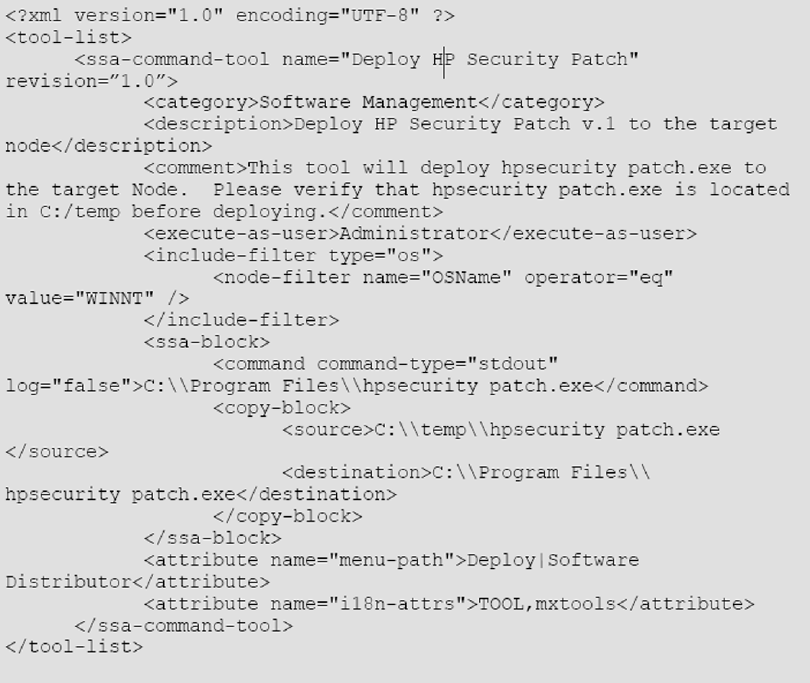HP Systems Insight Manager 7.0 User Guide
Table Of Contents
- Systems Insight Manager 7.0 User Guide
- Table of Contents
- Part I Introduction
- Part II Setting up HP SIM
- 3 Setting up managed systems
- 4 Credentials
- 5 WMI Mapper Proxy
- 6 Discovery
- 7 Manage Communications
- 8 Automatic event handling
- 9 Users and Authorizations
- 10 Managed environment
- Part III HP SIM basic features
- 11 Basic and advanced searches
- 12 Monitoring systems
- 13 Event management
- 14 Reporting in HP SIM
- 15 HP SIM tools
- Part IV HP SIM advanced features
- 16 Collections in HP SIM
- 17 HP SIM custom tools
- 18 Federated Search
- 19 CMS reconfigure tools
- 20 Understanding HP SIM security
- 21 Privilege elevation
- 22 Contract and warranty
- 23 License Manager
- 24 Storage integration using SMI-S
- 25 Managing MSCS clusters
- 26 HP SIM Audit log
- 27 HP Version Control and HP SIM
- 28 Compiling and customizing MIBs
- A Important Notes
- System and object names must be unique
- Setting the Primary DNS Suffix for the CMS
- Distributed Systems Administration Utilities menu options not available
- Virtual machine guest memory reservation size
- Insight Remote Support Advanced compatibility
- Database firewall settings
- Annotating the portal UI
- Security bulletins
- Validating RPM signatures
- Central Management Server
- Complex systems displaying inconsistency with the number of nPars within the complex
- Configure or Repair Agents
- Data collection reports
- B Troubleshooting
- Authentication
- Browser
- Central Management Server
- Complex
- Configure or Repair Agents
- Container View
- Credentials
- Data Collection
- Database
- Discovery
- iLO
- Linux servers
- Event
- Host name
- HP Insight Control power management
- Insight Control virtual machine management
- HP Smart Update Manager
- Systems Insight Manager
- Identification
- Installation
- License Manager
- Locale
- Managed Environment
- HP MIBs
- Onboard Administrator
- OpenSSH
- Performance
- Ports used by HP SIM.
- Privilege elevation
- Property pages
- Reporting
- Security
- Sign-in
- SNMP settings
- SSH communication
- System Page
- System status
- Target selection wizard
- Tasks
- Tools
- Upgrade
- UUID
- Virtual identifiers
- Virtual machines
- VMware
- WBEM
- WBEM indications
- WMI Mapper
- C Protocols used by HP SIM
- D Data Collection
- E Default system tasks
- Biweekly Data Collection
- System Identification
- Old Noisy Events
- Events Older Than 90 Days
- Status Polling for Non Servers
- Status Polling for Servers
- Status Polling for Systems No Longer Disabled
- Hardware Status Polling for Superdome 2 Onboard Administrator
- Data Collection
- Hardware Status Polling
- Version Status Polling
- Version Status Polling for Systems no Longer Disabled
- Check Event Configuration
- Status polling
- F Host file extensions
- G System Type Manager rules
- H Custom tool definition files
- I Out-of-the-box MIB support in HP SIM
- J Support and other resources
- Glossary
- Index

The fully composed TDEF for a SSA copy tool to deploy the HP Security Patch to a managed
node and then execute, should display as follows:
10. Save the file. HP recommends using a file name that indicates its function, in this
case,DeployHPSecurityPatchv.1.xml Make sure that the file name ends with the .XML
extension. Note that file names on Linux and HP-UX operating systems are case-sensitive. The
directory used by HP SIM to store tools is as follows:
• for HP-UX and Linux systems: /var/opt/mx/tools
• for Windows systems: C:\Program Files\HP\Systems Insight Manager\tools
11. To add the new tool to HP SIM, perform the procedure described in the section “Adding a
TDEF to HP SIM”.
For more information about specific SSA tool attributes, see “SSA-specific attributes”.
Example Web launch tool
A web launch tool launches an application requiring a URL. The example below launches the
application WebJetAdmin for a device selected within the HP SIM window as long as that device
is a printer. The <web-block> element (in bold below) provides the URL of the managed node
where WebJetAdmin is installed. The parameter %n is used to substitute the managed node
hostname. The <toolbox-enabled> element can have a value of true or false. If the <toolbox-enabled>
element is true, it will be associated with the Toolboxes under HP SIM User and Authorization. This
allows a trusted user to disable the tool in the Toolbox if the value is false. This tool launches in a
separate browser window using the "target-frame" of WJAFrame. For additional parameters, see
“mxtool command parameters”.
104 HP SIM custom tools










